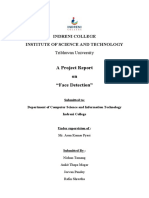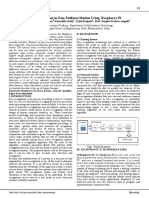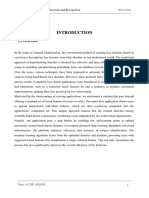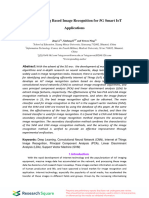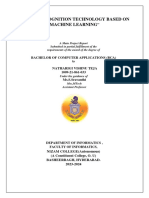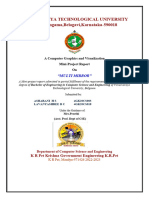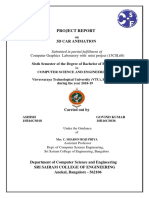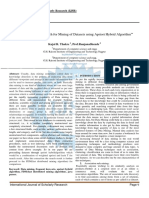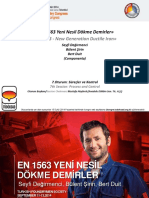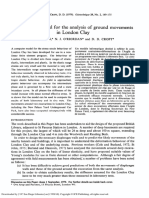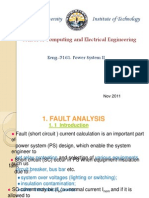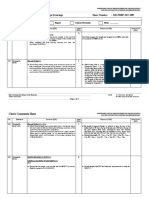"Implementation On A 3D Image Password": International Journal of Scholarly Research (IJSR) Vol-1, Issue-1, 2017
"Implementation On A 3D Image Password": International Journal of Scholarly Research (IJSR) Vol-1, Issue-1, 2017
Uploaded by
International Journal of Scholarly ResearchCopyright:
Available Formats
"Implementation On A 3D Image Password": International Journal of Scholarly Research (IJSR) Vol-1, Issue-1, 2017
"Implementation On A 3D Image Password": International Journal of Scholarly Research (IJSR) Vol-1, Issue-1, 2017
Uploaded by
International Journal of Scholarly ResearchOriginal Title
Copyright
Available Formats
Share this document
Did you find this document useful?
Is this content inappropriate?
Copyright:
Available Formats
"Implementation On A 3D Image Password": International Journal of Scholarly Research (IJSR) Vol-1, Issue-1, 2017
"Implementation On A 3D Image Password": International Journal of Scholarly Research (IJSR) Vol-1, Issue-1, 2017
Uploaded by
International Journal of Scholarly ResearchCopyright:
Available Formats
International Journal of Scholarly Research (IJSR)
Vol-1, Issue-1, 2017
http://www.scholars.org.in
Implementation on a 3D Image Password"
Diksha Ramteke1, Gyaneshwari Humne2 , Riya Rangari3, Sana Gufra4, Zeba Tehreem5, prof. Nazish khan6
1
Departement of computer science and engg,
Anjuman College of Engineering and Technology, Nagpur
dikshu24011994@gmail.com
2
Departement of computer science and engg,
Anjuman College of Engineering and Technology, Nagpur
humnegyaneshwari@gmail.com
3
Departement of computer science and engg,
Anjuman College of Engineering and Technology, Nagpur
rangaririya23@gmail.com
4
Departement of computer science and engg,
Anjuman College of Engineering and Technology, Nagpur
sanagufra@gmail.com
5
Departement of computer science and engg,
Anjuman College of Engineering and Technology, Nagpur
zebatehreem28@gmail.com
6
Departement of computer science and engg,
Anjuman College of Engineering and Technology, Nagpur
nazish07@rediffmail.com
Abstract: Development of 3D face model from 2D images has has motivated researchers to develop computational models to
its very important role in many authentication and security identify the faces, which are easy and simple to implement.
related areas. And many organization required a system to In biometric system there are different types are techniques
measure persons authenticity and get them authority of and concepts are used for security purpose. In biometric
relevant organization secrete precious data through this system we use our face, fingerprints, palm, eyes and ears,
authentication. So focusing on two point of maintaining voices different part of our body for reorganization process
privacy and security of data as well as authenticating user of and after that give the authentication to user. Some
the data is mainly targeted. So in our development work we advancement in biometric system there will be a Multi Modal
have proposed 3D (Three dimensional) image authentication biometric techniques are in front of us with more security and
model. In this paper we proposed a 3D images authentication privacy than biometric system. In Multi Modal biometric
by taking different 2D images from different directions and system we recognized more than one part of human body for
converting it by using LDA(Linear Discriminant Analysis) and verification and identification of the user. And integrating that
SIFT (Scale Invariant Feature Transforms) algorithms. We are result of different parts of reorganization process and
also using OpenCV library function for reorganization of comparing that resulted output with the database data. If match
image through android device. After comparing all the images will found user allow to access or user allow entering into
and on the bases of result of comparisons we will give organization. This system restrict the user to illegally use the
authority to the user to enter into system. This system will private most secrete things of someone else.
definitely give the better result as compare to other in term of By these technique many organization has get relaxation from
security and authentication. the issue of privacy of the private data or organization. I real
world many organization or many application will using this
Keyword: Image reorganization, 3D image conversion, privacy technique for authentication and identification of
OpenCv library, LDA and SIFT. person. Nevertheless, apart from all these technique the
developer never stop at one place for the innovation and
1. INTRODUCTION making the things more powerful.
Face recognition is the technique, which can be applied to the Now this is world of smart-phone user with android
wide variety of problems like image and film processing, functionality. People built many apps on the android base.
human computer interaction, criminal identification etc. This There will be very radical changes over the smart- phone. In
International Journal of Scholarly Research Page 14
International Journal of Scholarly Research (IJSR)
Vol-1, Issue-1, 2017
http://www.scholars.org.in
android, there are many apps that provide the authentication separability in order avoid over fitting (annoyance of
through the login and password but the authentication is not so dimensionality) and reduce computational expenses. It is a
much secure in it. There will be another authentication are classification method formerly developed in 1936 by R. A.
available in the android platform. We are also working on this Fisher. It is simple, accurately robust and often manufactures
authentication technique but not through voice detection or models whose exactness is methods that are as good as more
login details. We are making a use of 3D images for multifaceted.
authentication purpose.
We are aiming at this technique with android as a platform SIFT (Scale Invariant Image Transform):
because these biometrics and multi Modal biometrics systems Harmonizing features by using different images is a common
are very expensive and not used in a android application. In problem in computer visualization. When all images are
addition, does not make any sense to use it in any android app. similar in scenery or nature (same scale, orientation, etc)
So make available a more security through the android device simple corner detectors can work. However, when you have
with a cheap costing and more users friendly and easy to images of different scales and rotations, you need to use the
usable application in this world we are proposing this system Scale Invariant Feature Transform. After you run through the
model. algorithm, you will have SIFT features for your image. Track
Here we are proposing an efficient approach for image images, identify and recognize objects (which can be partly
recognition. To demonstrate the image recognition system in hidden as well), or whatever you can think of.
android device by taking multiple 2D images. The system can
be used as the base for the development of the recognition of OpenCV Library:
human identity. Test images and training images are taken OpenCV (Open Source Computer Vision Library) is an open
directly with the camera in android device. The test results will resource computer idea and machine learning software library.
show the system's high accuracy. The goal is to implement OpenCV built to make available a common transportation for
eigenface based 3D model for a particular face and distinguish computer vision applications and to increase speed the use of
it with input image. machine discernment in the upcoming products. BSD-licensed
In order to protect any system the User Authentication plays a product, OpenCV makes it easy for businesses to utilize and
major role. Image recognition can easily be installed on modify the code.
Android since Android mobile have all embedded hardware
like high definition camera for image clicking functionality. 2. RELATED WORK
However, to have our own algorithm, we have to recreate all For constructing this system application we have search many
the processes from the beginning. Our Approach will describe related working of other developers and grab ideas from there
the way we took to implement as well as possible a new Image working. However, we are describing some work of others
recognition algorithm.
with their system requirements and experimental result.
As we know, all the android devices have an inbuilt camera
with more accuracy in that with pixel quality. So we can Juwei Lu, K. N. Plataniotis and A. N. Venetsanopoulos [1]
suspect a good quality image through this hardware which is they propose a kernel machine-based discriminant analysis
already present and we dont have to take more efforts for method, which deals with the non-linearity of the face patterns'
these problem for good quality image. But the image is taken it division. The previous technique also successfully solves the
the form of 2D image so our main task is to convert that 2D so-called "small sample size" (SSS) problem, which present in
image into 3D (three dimension image). So that purpose we most FR (Face reorganization) tasks. The new algorithm has
are using two algorithms LDA (linear discriminate analysis) been tested, in terms of classification error rate performance,
and SIFT (Scale Invariant Feature Transforms). In addition, on the multi-view UMIST face database. Consequences point
we are using OpenCV library function, which is a library used toward that the proposed methodology is able to achieve
for image reorganization purpose and integrate all the outstanding performance with only a very small set of features
algorithms, which we are using in these system development. being used, and its error rate is just about 34% and 48% of
those of two other commonly used kernel FR approachs, the
The short description is as follows for all the algorithms: kernel-PCA (KPCA) and the generalized discriminant analysis
(GDA), correspondingly.
LDA (Linear Discriminate Analysis): Lin Zhang ,Lida Li, Hongyu Li, and Meng Yang[2] proposing
Linear Discriminant Analysis (LDA) most commonly used as a narrative 3D ear classification proposal that makes use of the
dimensionality reduction technique in the pre-processing step label reliable K-SVD (LC-KSVD) framework. As an
for pattern-classification and machine learning applications as successful supervised dictionary learning algorithm, LC-
we do in the data mining applications. The goal is to project a KSVD learns a single compressed discriminative dictionary
dataset onto a lower-dimensional space with good class- for meager coding and a multi-class linear classifier
International Journal of Scholarly Research Page 15
International Journal of Scholarly Research (IJSR)
Vol-1, Issue-1, 2017
http://www.scholars.org.in
concurrently. To use the LC-KSVD framework, one primary Below are the brief descriptions of algorithms used in our
issue is how to extract feature vectors from 3D ear scans. To proposed system work:
this end, they propose a block wise statistics-based feature
extraction scheme. Particularly, they split a 3D ear area of 1. OpenCv Library:
interest into homogeneous blocks and extract a histogram of OpenCV (Open Source Computer Vision Library) is an open
surface types from each block; histograms from all blocks are resource computer vision and machine learning software
then merged to form the preferred feature vector. library which is available online to any one and in android
Jieping Ye, Ravi Janardan, Qi Li [3] they proposed a orignal platform we can use this built in functionality and integrate
LDA algorithm, namely 2DLDA, which stands for 2- more than one algorithm. OpenCV was built to provide a
Dimensional Linear Discriminant Analysis. 2DLDA beats the common transportation for computer vision applications and to
singularity problem absolutely, while achieving effectiveness. speed up the use of machine observation in the profitable
The primary difference between 2DLDA and classical LDA products. The library has more than 2500 optimized
lies in the model for data demonstration. Traditional LDA algorithms, which comprises a widespread set of both
works with vectorized illustrations of data, while the 2DLDA traditional and state-of-the-art computer idea and machine
algorithm works with data in matrix illustration. Further learning algorithms. These algorithms can be used to perceive
diminish the dimension by 2DLDA, the combination of and recognize faces, identify objects, classify human actions in
2DLDA and classical LDA, namely 2DLDA+LDA, is studied, videos, track camera movements, track moving objects, extract
where LDA is come first by 2DLDA. The previous algorithms 3D models of objects, produce 3D point clouds from stereo
are functional on face recognition and compared with cameras, stitch images together to produce a high resolution
PCA+LDA. Experiments show that 2DLDA and image of an entire scene, find similar images from an image
2DLDA+LDA accomplish spirited recognition accuracy, while database, remove red eyes from images taken using flash,
being much more efficient. follow eye movements, recognize scenery and establish
markers to overlay it with augmented reality, etc.
3. PROPOSED METHOD 2. Linear Discriminant Analysis (LDA):
By study of the related work and there functionality we have LDA is a technique used for data classification and
decided to develop a system for Android platform. As we dimensionality reduction. LDA can efficiently handle the
know by using, android platform we can built the application situation where we have to perform classification on within-
for authentication purpose that we want for 3D image class uneven data and the data that generated through the
authentication. By using android platform there is very simple randomly generated test data.
to design a structure of the application because android support
both java and XML features. Through XML, we can design a DIFFERENT APPROACHES TO LDA:
good eye-catching user interface (UI) and through java we Data sets can transform and test vectors can be classified in the
make a connectivity to that UI. transformed space by two different approaches.
Firstly, we are maintained one database where all user saved
data for login or authentication purpose is stored as user Class-dependent transformation: This type of approach
identity proof. After that, there will be one login form as if contains increasing the ratio of between class inconsistencies
instead of giving user name and password the users have to to within class inconsistency. The main objective is to increase
give the three different images as a test database. These three this proportion so that satisfactory class separability is
different images are compared with the image stored in the acquired. The class-specific type approach includes using two
database. However, before the comparison we have to apply optimizing criterion for transforming the data sets
LDA (Linear Discriminant Analysis) and SIFT (Scale autonomously.
Invariant Feature Transform). LDA is techniques for data
classification and dimensionality reduction. Linear Class-independent transformation: This approach includes
Discriminant Analysis easily handles the situation where the increasing the proportion of in general inconsistency to within
within-class frequencies are uneven and their performances class inconsistency. This approach uses only one optimizing
have been examined on indiscriminately generated test data. criterion to transform the data sets and hence all data points
This method increases the ratio of between-class inconsistency irrespective of their class characteristics are transformed using
to the within-class inconsistency in any particular data set this transform. In this type of LDA, each class is measured as a
thereby assuring maximal separability. SIFT is used for feature split class against all other classes.
extraction process from a different test data. For this two
functionality of image recognization, we required OpenCV MATHEMATICAL OPERATIONS OF LDA:
library function to monitoring the equipment just like mobile In this section, the mathematical operations concerned in
camera and coordinating different algorithms. using LDA will be examined.
International Journal of Scholarly Research Page 16
International Journal of Scholarly Research (IJSR)
Vol-1, Issue-1, 2017
http://www.scholars.org.in
i. Devise the data sets and the test sets, which are to be
classified in the inventive space.
ii. Compute the mean of each data set and mean of
entire data set.
iii. In LDA, within-class and between-class distribute are
used to devise criteria for class separability. Within-
class scatter is the predictable covariance of each of
the classes.
iv. By definition, an eigen vector of a alteration
represents a 1-D invariant subspace of the vector
space in which the transformation is applied. A set of
these eigen vectors whose
v. Corresponding eigen values are non-zero are all
linearly autonomous and are invariant under the
transformation.
vi. For any L-class problem we would always have L-1
non-zero eigen values. Figure 3. Figure for eigen vector path in class independent
vii. Once the transformations are finished using the LDA type
transforms, Euclidean distance or RMS expanse is
used to classify data points. 3. Scale Invariant Image Transform (SIFT):
For any object there are many features, attractive points on the
object that can be fetched to provide a "feature" explanation of
the object. This explanation can then be used when required to
position the object in an image including many other objects.
SIFT image features present a set of features or characteristics
of an object that are not exaggerated by many of the
difficulties experienced in other methods, such as object
scaling and rotation.
The SIFT approach, for image feature production, takes an
image and convert it into a "large collected works of local
feature vectors".
Figure 2. Figure for eigen vector path in class dependent
type
International Journal of Scholarly Research Page 17
International Journal of Scholarly Research (IJSR)
Vol-1, Issue-1, 2017
http://www.scholars.org.in
Fig.3. Flowchart of overview of SIFT
i. Constructing Scale Space: Gaussian kernel used to
create scale space.
Only possible scale space kernel
Where
ii. Laplacian of Gaussians:
LoG - 22G Extrema Useful, Found to be stable
features. Gives Excellent notion of scale vi. Filter Low Contrast Points:
Low Contrast Points Filter
iii. Difference of Gaussian: Use Scale Space value at previously found
Approximation of Laplacian of Gaussians location
vii. Orientation Assignment:
A. Compute Gradient for each blurred image
B. For region around keypoint
Create Histogram with 36 bins for orientation
Weight each point with Gaussian window of 1.5
Create keypointfor all peaks with value>=.8 max
bin
iv. Locate the Extrema of the DoG: Note that a parabola is fit to better locate each
1. Scan each DOG image max (least squares)
2. Look at all neighboring points (including scale)
viii. Building the Descriptor
3. Identify Min and Max Find the blurred image of closest scale.
4. 26 Comparisons Sample the points around the keypoint.
Rotate the gradients and coordinates by the
v. Sub-pixel Localization: previously computer orientation.
3D Curve Fitting, Taylor Series Expansion Separate the region in to sub regions.
Create histogram for each sub region with 8 bins.
a. Weight the samples with N() = 1.5 Region width
b. Trilinear Interpolation (1-d factor) to place in
histogram bins
Differentiate and set to 0
4. CONCLUSIONS
to get location in terms of (x,y,) As we discussed in this paper about Implementation 3D Image
Authentication Technique for authentication. By using
Android platform and OpenCV library function we make our
work easier as compare to others for algorithmic purpose.
Then after decided to use LDA and SIFT for classification and
image feature extraction process. And as a result we have
International Journal of Scholarly Research Page 18
International Journal of Scholarly Research (IJSR)
Vol-1, Issue-1, 2017
http://www.scholars.org.in
obtained a better outcome than other technique in more from range images. In: IEEE Computer Society
efficient and easy to handle with great user interface. Workshop on Interpretation of 3D Scenes, pp. 194
199 (1989)
5. REFERENCES
[11] Chang, K., Bowyer, K., Flynn, P.: Face recognition
[1] Juwei Lu, K. N. Plataniotis and A. N. using 2D and 3D facial data. In: Proceedings of the
Venetsanopoulos, "Face recognition using kernel Workshop in Multimodal User Authentication, pp.
direct discriminant analysis algorithms," in IEEE 2532 (2003)
Transactions on Neural Networks, vol. 14, no. 1, pp.
117-126, Jan 2003.
[12] Chua, C., Han, F., Ho, Y.: 3D human face recognition
[ 2 ] Lin Zhang ,Lida Li, Hongyu Li, and Meng Yang, using point signature. In: Proceedings of the 4th IEEE
Two-Dimensional Linear Discriminant Analysis. International Conference on Automatic Face and
Gesture Recognition, p. 233 (2000)
[3] Benz, M., Laboureux, X., Maier, T., Nkenke, E.,
Seeger, S., Neukam, F., Husler, G.: The symmetry [13] Hallinan, P., Gorden, G., Yuille, A., Giblin, P.,
of faces. In: Proceedings of Vision, Modeling and Mumford, D.: Two and three-dimensional patterns of
Visualization, pp. 4350 (2002) the face. Peters, Wellesley, MA (1999).
[4] Besl, P., McKay, N.: A method for registration of 3-D [14] Hamann, B.: Curvature approximation for
shapes. IEEE Trans. Pattern Anal. Mach. Intell. 14(2), triangulated surfaces. In: Farin, G., Hagen, H.,
239256 (1992)Google Scholar Notemeier, H., Knodel, W. (eds.) Geometric
Modelling. Springer, Berlin Heidelberg New York,
[5] Beumier, C., Acheroy, M.: Automatic 3D face pp. 139153 (1993)
authentication. Image Vis. Comput. 18(4), 315321
(2000)Google Scholar [15] Kazhdan, M., Chazelle, B., Dobkin, D., Funkhouser,
T., Rusinkiewicz, S.: A reflective symmetry
[6] Beumier, C., Acheroy, M.: Automatic face descriptor for 3D models. Algorithmica 38(1), 201
verification from 3D and grey level clues. Pattern 225 (2003)Google Scholar
Recog. Lett. 22(12), 13211329 (2001)Google
Scholar [16] Lee, M., Ranganath, S.: Pose-invariant face
[7] Blanz, V., Vetter, T.: Face recognition based on recognition using a 3D deformable model. Pattern
fitting a 3D morphable model. IEEE Trans. Pattern Recog. 36(8), 18351846 (2003)Google Scholar
Anal. Mach. Intell. 25(9), 10631074 (2003)Google
Scholar [17] Liu, Y., Schmidt, K., Cohn, J., Weaver, R.: Facial
asymmetry quantification for expression invariant
[8] Bowyer, K., Chang, K., Flynn, P.: A survey of 3D human identification. Comput. Vis. Image
and multi-modal 3D+2D face recognition. Notre Understand. 91(12), 138159 (2003)Google Scholar
Dame CSE Technical Report (2004)
[18] Minovic, P., Ishikawa, S., Kato, K.: Three-
[9] Bronstein, A., Bronstein, M., Kimmel, R.: Expression dimensional symmetry measurement of medical
invariant 3D face recognition. In: Proceedings of the entities. In: Proceedings of the 11th International
International Conference on Audio and Video Based Conference on Pattern Recognition: Conference A:
Biomeasure Person Authentication, pp. 6270 (2003) Computer Vision and Applications, pp. 457460
(1992)
[10] Cartoux, J., Lapreste, J., Richetin, M.: Face
authentification or recognition by profile extraction
International Journal of Scholarly Research Page 19
International Journal of Scholarly Research (IJSR)
Vol-1, Issue-1, 2017
http://www.scholars.org.in
[19] Moreno, A., Snchez, ., Vlez, J., Daz, F.: Face
recognition using 3D surface-extracted descriptors.
In: Proceedings of the 7th Irish Conference on
Machine Vision and Image Processing, Antrim, N.
Ireland (2003)
[20] OMara, D., Owens, R.: Measuring bilateral
symmetry in three dimensional magnetic resonance
images. In: Attikiouzel, Y. (ed.) 1996 IEEE Region
Ten Conference: Digital Signal Processing
Applications, IEEE Service Center, pp. 151156
(1996)
[21] Reisfeld, D., Wolfson, H., Yeshurun, Y.: Detection of
interest points using symmetry. In: Proceedings of the
International Conference on Computer Vision, pp.
6265 (1990)
[22] Turk, M., Pentland, A.: Face recognition using
eigenfaces. In: Proceedings of the Conference on
Computer Vision and Pattern Recognition, pp. 586
591 (1991)
[23] Tuzikov, A., Colliot, O., Bloch, I.: Brain symmetry
plane computation in MR images using inertia axes
and optimization. In: Proceedings of the International
Conference on Pattern Recognition, pp. 516519
(2002)
International Journal of Scholarly Research Page 20
You might also like
- Proline 21 h800 Cap 34Document327 pagesProline 21 h800 Cap 34danielNo ratings yet
- 1RN19CS410 Rashmi (CGV Project Report)Document33 pages1RN19CS410 Rashmi (CGV Project Report)RASHMI100% (3)
- Iot Based Home Security Through Image Processing Algorithms: Issn: 2454-132X Impact Factor: 4.295Document5 pagesIot Based Home Security Through Image Processing Algorithms: Issn: 2454-132X Impact Factor: 4.295mohsin ahmedNo ratings yet
- Indreni College Institute of Science and Technology: A Project Report On "Face Detection"Document10 pagesIndreni College Institute of Science and Technology: A Project Report On "Face Detection"Jeevan PandeyNo ratings yet
- Face Detection and Recognition Using Opencv and PythonDocument3 pagesFace Detection and Recognition Using Opencv and PythonGeo SeptianNo ratings yet
- Smart Attendance System Using Face RecognitionDocument4 pagesSmart Attendance System Using Face RecognitionVanusha KalaichelvanNo ratings yet
- c2390573-3bbf-436a-9f9d-053ac5b9d8cdDocument30 pagesc2390573-3bbf-436a-9f9d-053ac5b9d8cdkaranofficial38No ratings yet
- Designing Iot Face Recognition Robot: Shreenivas TelkarDocument5 pagesDesigning Iot Face Recognition Robot: Shreenivas Telkarsurajmore2368No ratings yet
- a-survey-of-face-detection-and-recognition-systemDocument15 pagesa-survey-of-face-detection-and-recognition-systemJuan Pablo MansonNo ratings yet
- Project Report Format For CollegeDocument13 pagesProject Report Format For CollegeTik GamingNo ratings yet
- A Generative Adversari AL Network Based Deep Learning Method For Low Quality Defect Image Reconstruction and RecognitionDocument4 pagesA Generative Adversari AL Network Based Deep Learning Method For Low Quality Defect Image Reconstruction and RecognitionGabriel DAnnunzioNo ratings yet
- Face Sketch Construction and Recognition SynopsisDocument11 pagesFace Sketch Construction and Recognition Synopsissarthakpawar0016No ratings yet
- ReportDocument10 pagesReportaa1150No ratings yet
- Eye GestureDocument6 pagesEye GesturemohansomalliNo ratings yet
- IJCRTAB02162Document6 pagesIJCRTAB02162shrivastavshamkumarNo ratings yet
- Oodp Project ReportDocument20 pagesOodp Project Reportsyedshahabudeen133No ratings yet
- Face Detection Tracking OpencvDocument6 pagesFace Detection Tracking OpencvMohamed ShameerNo ratings yet
- Smart Attendance System Using Face Recognition: Journal of Advanced Research in Dynamical and Control Systems May 2020Document7 pagesSmart Attendance System Using Face Recognition: Journal of Advanced Research in Dynamical and Control Systems May 2020Usha ParmarNo ratings yet
- Arduino Based FCSDocument69 pagesArduino Based FCSMaximilian SylvesterNo ratings yet
- harishchandrap,+25.+Image+Processing FullpaperDocument9 pagesharishchandrap,+25.+Image+Processing FullpaperhieuNo ratings yet
- Irjet V8i5356Document4 pagesIrjet V8i5356team pagalNo ratings yet
- Department of Masters of Comp. ApplicationsDocument10 pagesDepartment of Masters of Comp. ApplicationsJani MuzaffarNo ratings yet
- Handwritten Mathematical Expression Solver Using CNNDocument8 pagesHandwritten Mathematical Expression Solver Using CNNIJRASETPublicationsNo ratings yet
- Face Detection by Using OpenCVDocument4 pagesFace Detection by Using OpenCVvickey rajputNo ratings yet
- Face Recognition in Non-Uniform Motion Using Raspberry Pi: 15 IJRE - Vol. 03 No. 05 - May 2016Document3 pagesFace Recognition in Non-Uniform Motion Using Raspberry Pi: 15 IJRE - Vol. 03 No. 05 - May 2016Abraham CandelariaNo ratings yet
- Save Our Ships SOS-An Android Application For SafetyDocument8 pagesSave Our Ships SOS-An Android Application For SafetyIJRASETPublicationsNo ratings yet
- B.M.S College of Engineering: (Autonomous Institution Under VTU) Bangalore-560 019Document25 pagesB.M.S College of Engineering: (Autonomous Institution Under VTU) Bangalore-560 019Aishwarya NaiduNo ratings yet
- Project Report - Face Emotion TrackingDocument12 pagesProject Report - Face Emotion Trackinganshumanmishra.aiNo ratings yet
- Sathyabama: Smart System For Presentations Using Gesture ControlDocument36 pagesSathyabama: Smart System For Presentations Using Gesture Controlshaileshpawark11No ratings yet
- 3D REPORTDocument44 pages3D REPORTindrasingh83533No ratings yet
- Svdroid: Singular Value Decomposition With CNN For Android Malware ClassificationDocument15 pagesSvdroid: Singular Value Decomposition With CNN For Android Malware ClassificationShri Ramya PerumalNo ratings yet
- IOT Based Smart Attendance System Using Face Recognition: Vedang Choudhari, DR - Sarika Panwar, Bhavesh HoleyDocument4 pagesIOT Based Smart Attendance System Using Face Recognition: Vedang Choudhari, DR - Sarika Panwar, Bhavesh HoleyBhavesh HoleyNo ratings yet
- Project Phase-1 Final Report!Document18 pagesProject Phase-1 Final Report!kaakhilesh159No ratings yet
- Proposal For A System Analysis ProjectDocument13 pagesProposal For A System Analysis ProjectiknowthissabrinaNo ratings yet
- Paper 8901Document5 pagesPaper 8901IJARSCT JournalNo ratings yet
- Image Recognition With Machine Learning: Parth Kumar ThakurDocument6 pagesImage Recognition With Machine Learning: Parth Kumar Thakurmanar ahmedNo ratings yet
- ResumeDocument1 pageResumesapanNo ratings yet
- Face Recognition Voiting System Using IotDocument11 pagesFace Recognition Voiting System Using IotKittuNo ratings yet
- Enhanced Technique For Multiple Face Detection Based On LBPH (Local Binary Patterns Histograms) A ReviewDocument6 pagesEnhanced Technique For Multiple Face Detection Based On LBPH (Local Binary Patterns Histograms) A ReviewIJRASETPublicationsNo ratings yet
- Crowd Monitoring Using HOGDocument8 pagesCrowd Monitoring Using HOGInternational Journal of Innovative Science and Research TechnologyNo ratings yet
- Cursor ManipulationDocument22 pagesCursor Manipulationmithun.sweNo ratings yet
- Summary of The Thesis Revised 26 July 2017Document65 pagesSummary of The Thesis Revised 26 July 2017DIPAK VINAYAK SHIRBHATENo ratings yet
- Deep Learning Based Image Recognition For 5G SmartDocument19 pagesDeep Learning Based Image Recognition For 5G SmartVM SARAVANANo ratings yet
- Real-Time Object and Face Monitoring Using Surveillance VideoDocument8 pagesReal-Time Object and Face Monitoring Using Surveillance VideoIJRASETPublicationsNo ratings yet
- Image Recognition Technology Based On Machine LearningDocument22 pagesImage Recognition Technology Based On Machine LearningVishnu NATHARIGINo ratings yet
- B16 Paper IEEEDocument6 pagesB16 Paper IEEEAman PrasadNo ratings yet
- Ijstmr V2i3 1493Document3 pagesIjstmr V2i3 1493msk.official321No ratings yet
- Face Detection and Recognition System: Mr. Tilak Pandya, Mr. Praveen Chauhan, Ms. Viplavi PanchalDocument8 pagesFace Detection and Recognition System: Mr. Tilak Pandya, Mr. Praveen Chauhan, Ms. Viplavi PanchaliajerNo ratings yet
- Shifa Badesha - ResumeDocument3 pagesShifa Badesha - Resumesbadesha24No ratings yet
- Multi MirrorDocument39 pagesMulti Mirrorpreethipgowda2004No ratings yet
- AvishkaaaaaaaDocument14 pagesAvishkaaaaaaaAman YadavNo ratings yet
- NTCC Term Paper NoniDocument20 pagesNTCC Term Paper NoniRohan PrabhakarNo ratings yet
- Device Aware Light PaintingDocument45 pagesDevice Aware Light PaintingNazerke SafinaNo ratings yet
- Face Recognition Based Attendance System: Problem StatementDocument4 pagesFace Recognition Based Attendance System: Problem StatementPriya RathiNo ratings yet
- HAR PaperDocument6 pagesHAR PapershivamNo ratings yet
- 8511 ArticleText 9505 1 10 20231102Document10 pages8511 ArticleText 9505 1 10 20231102Sagar SadakeNo ratings yet
- Mini Project ReportDocument22 pagesMini Project Reportunknownshambhu1008No ratings yet
- 3D Car Project ReportDocument43 pages3D Car Project ReportRoshan kumar mahatoNo ratings yet
- Synopsis PROJECT 24 (G-10)Document10 pagesSynopsis PROJECT 24 (G-10)shrey.bhaskar.it.2021No ratings yet
- "Implementation On An Efficient Approach For Ranking Based Fraud Detection in AndroidDocument6 pages"Implementation On An Efficient Approach For Ranking Based Fraud Detection in AndroidInternational Journal of Scholarly ResearchNo ratings yet
- Implementation On Health Care Database Mining in Outsourced DatabaseDocument5 pagesImplementation On Health Care Database Mining in Outsourced DatabaseInternational Journal of Scholarly ResearchNo ratings yet
- Implementation of Ranking Based Fraud Detection SystemDocument6 pagesImplementation of Ranking Based Fraud Detection SystemInternational Journal of Scholarly ResearchNo ratings yet
- Implementation of Unimodal To Multimodal Biometric Feature Level Fusion of Combining Face Iris and Ear in Multi-Modal Biometric SystemDocument5 pagesImplementation of Unimodal To Multimodal Biometric Feature Level Fusion of Combining Face Iris and Ear in Multi-Modal Biometric SystemInternational Journal of Scholarly ResearchNo ratings yet
- "Implementation On An Approach For Mining of Datasets Using APRIORI HybridDocument5 pages"Implementation On An Approach For Mining of Datasets Using APRIORI HybridInternational Journal of Scholarly ResearchNo ratings yet
- Implementation On Proxy-Re-Encryption Based Security Mechanism ToDocument5 pagesImplementation On Proxy-Re-Encryption Based Security Mechanism ToInternational Journal of Scholarly ResearchNo ratings yet
- Review On Health Care Database Mining in Outsourced DatabaseDocument4 pagesReview On Health Care Database Mining in Outsourced DatabaseInternational Journal of Scholarly ResearchNo ratings yet
- Implementation of Efficient Approach Towards Classification of Semantically Secure Encrypted DataDocument4 pagesImplementation of Efficient Approach Towards Classification of Semantically Secure Encrypted DataInternational Journal of Scholarly ResearchNo ratings yet
- A Brief Review On Different Security Mechanism in Cloud ComputingDocument4 pagesA Brief Review On Different Security Mechanism in Cloud ComputingInternational Journal of Scholarly ResearchNo ratings yet
- 02 AratiTuleDocument6 pages02 AratiTuleInternational Journal of Scholarly ResearchNo ratings yet
- KajalReviewDocument5 pagesKajalReviewInternational Journal of Scholarly ResearchNo ratings yet
- 4 SumitkaleDocument5 pages4 SumitkaleInternational Journal of Scholarly ResearchNo ratings yet
- SakshigabahneDocument3 pagesSakshigabahneInternational Journal of Scholarly ResearchNo ratings yet
- Digital System Design 1 - Chapter 1 SlideDocument44 pagesDigital System Design 1 - Chapter 1 Slide42200405No ratings yet
- Flip FlopsDocument35 pagesFlip FlopsGaurav0% (1)
- Bio-Vision - Plus One Maths Questions All UnitsDocument69 pagesBio-Vision - Plus One Maths Questions All Unitsnivedhithabiju008No ratings yet
- Code ReviewDocument2 pagesCode ReviewDharm PalNo ratings yet
- SPSS - Unit IDocument31 pagesSPSS - Unit IAllen Davis JamesNo ratings yet
- ECA Unit 5Document37 pagesECA Unit 5Komalaselvan VNo ratings yet
- EN1563 Yeni Nesil Dökme Demirler DoktaşDocument55 pagesEN1563 Yeni Nesil Dökme Demirler DoktaşBehdad ShariatiNo ratings yet
- Activity - On - Arrow (A-O-A) Network Planning Technique Drawing Project NetworkDocument9 pagesActivity - On - Arrow (A-O-A) Network Planning Technique Drawing Project NetworkbalsamNo ratings yet
- Crs 512 Lecture Note PDFDocument68 pagesCrs 512 Lecture Note PDF5r4n8qcvkkNo ratings yet
- 2017 Minisplit Floor Ceiling Inverter YORK YFJE (18-48) BZJ-160620 QCDocument4 pages2017 Minisplit Floor Ceiling Inverter YORK YFJE (18-48) BZJ-160620 QCLIMBERTH VELANo ratings yet
- Atxmega16 128a4uDocument121 pagesAtxmega16 128a4udiegoquindioNo ratings yet
- (Jee 2023 - Chemistry) - (Top 100 Problems) PDFDocument144 pages(Jee 2023 - Chemistry) - (Top 100 Problems) PDFNitin KansalNo ratings yet
- UNit 6 PDFDocument13 pagesUNit 6 PDFAnkit SinghNo ratings yet
- Halion 6 Halion Sonic (Se) 3: Version HistoryDocument35 pagesHalion 6 Halion Sonic (Se) 3: Version Historyroberto jackettiNo ratings yet
- 2025-ISB/ISC/ISL CM2150 Control SystemDocument7 pages2025-ISB/ISC/ISL CM2150 Control Systemralph arisNo ratings yet
- SAMS 101 Ways To Use Your Signal Generator 1963Document127 pagesSAMS 101 Ways To Use Your Signal Generator 1963kc8iaqNo ratings yet
- Balancing Chemical EquationsDocument38 pagesBalancing Chemical EquationsBoj N. BernardoNo ratings yet
- EBENEZER School Physics Worksheet 2 For PPDocument2 pagesEBENEZER School Physics Worksheet 2 For PPHirko BelayNo ratings yet
- PHCL Midterms - Lesson 3 (Percentage, Ratio Strength And, Other Expressions of Concentrations)Document4 pagesPHCL Midterms - Lesson 3 (Percentage, Ratio Strength And, Other Expressions of Concentrations)Lazaro, Javen Andrie A.No ratings yet
- A Computer Model For The Analysis of Ground Movements in London ClayDocument27 pagesA Computer Model For The Analysis of Ground Movements in London ClayAbdelmoez ElgarfNo ratings yet
- B.Tech. (Third Semester) Mechanical Engineering: Basics of Industrial Sociology, Economics & ManagementDocument10 pagesB.Tech. (Third Semester) Mechanical Engineering: Basics of Industrial Sociology, Economics & ManagementVishal KashyapNo ratings yet
- FaultDocument27 pagesFaultግርማ ገ.No ratings yet
- GLASSWARESDocument26 pagesGLASSWARESandie maxeyNo ratings yet
- Hanbell-RC Technical ManualDocument75 pagesHanbell-RC Technical ManualMyo SeinNo ratings yet
- 330853625 - م-م-بهاء سعد محمودDocument2 pages330853625 - م-م-بهاء سعد محمودMohammed RezkNo ratings yet
- 140 HDocument31 pages140 HAlex Castillo100% (3)
- #2.response To Comments Sheet - Package2 Part1 Design Drawing (DH-PBBP-IDC-009) - 210225Document6 pages#2.response To Comments Sheet - Package2 Part1 Design Drawing (DH-PBBP-IDC-009) - 210225eddieNo ratings yet
- P Scan For Ultrasonic TestingDocument4 pagesP Scan For Ultrasonic Testingsdmkl85No ratings yet
- The Matter-Wave Background of Titius-Bode RuleDocument6 pagesThe Matter-Wave Background of Titius-Bode RuleDezso SarkadiNo ratings yet



